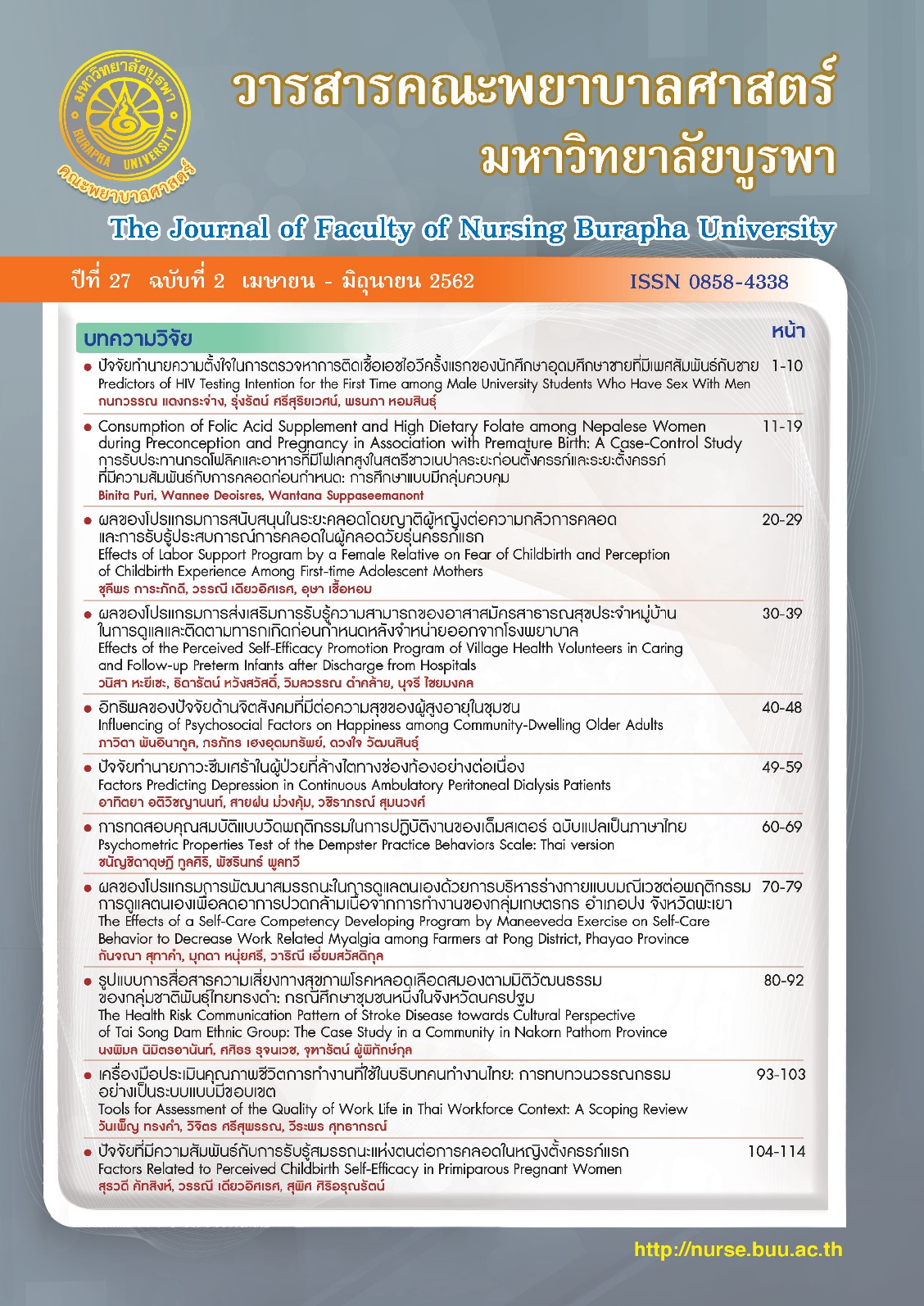ปัจจัยทำนายภาวะซึมเศร้าในผู้ป่วยที่ล้างไตทางช่องท้องอย่างต่อเนื่อง
คำสำคัญ:
การล้างไตทางช่องท้องอย่างต่อเนื่อง, ภาวะซึมเศร้าบทคัดย่อ
บทคัดย่อ
การวิจัยครั้งนี้มีวัตถุประสงค์เพื่อศึกษาปัจจัยทำนายภาวะซึมเศร้าในผู้ป่วยที่ล้างไตทางช่องท้องอย่างต่อเนื่อง โดยปัจจัยประกอบด้วยภาวะโภชนาการ ความแตกฉานด้านสุขภาพ และการสนับสนุนจากครอบครัว กลุ่มตัวอย่างเป็นผู้ป่วยที่ล้างไตทางช่องท้องอย่างต่อเนื่องที่มารับการรักษาที่คลินิกล้างไตทางช่องท้องอย่างต่อเนื่อง โรงพยาบาลชลบุรี และโรงพยาบาลมหาวิทยาลัยบูรพา จำนวน 119 ราย เครื่องมือที่ใช้ในการเก็บรวบรวมข้อมูลประกอบด้วย 1)แบบสัมภาษณ์ข้อมูลส่วนบุคคล 2)แบบประเมินภาวะโภชนาการ 3)แบบประเมินความแตกฉานด้านสุขภาพขั้นพื้นฐาน 4)แบบประเมินการรับรู้การสนับสนุนจากครอบครัว และ 5)แบบประเมินภาวะซึมเศร้าวิเคราะห์ข้อมูลโดยใช้สถิติบรรยาย และการวิเคราะห์การถดถอยพหุคูณแบบมีขั้นตอน ผลการวิจัยพบว่ากลุ่มตัวอย่างมีภาวะซึมเศร้าใน ร้อยละ 50.42 ภาวะโภชนาการ และการรับรู้การสนับสนุนจากครอบครัวสามารถร่วมกันทำนายภาวะซึมเศร้าได้ ร้อยละ 24.1 อย่างมีนัยสำคัญทางสถิติ (p < .05) ผลการศึกษานี้ให้ข้อเสนอแนะว่าบุคลากรทางด้านสุขภาพควรมีการประเมินภาวะซึมเศร้าในผู้ป่วยล้างไตทางช่องท้องอย่างต่อเนื่องเป็นระยะเพื่อสามารถวางแผนช่วยเหลือผู้ป่วยได้ถูกต้องและรวดเร็ว และส่งเสริมการสนับสนุนจากครอบครัวที่เหมาะสม รวมถึงการให้คำแนะนำเพื่อส่งเสริมภาวะโภชนาการ
เอกสารอ้างอิง
Artiwitchayanon, A., Keeratiyutawong, P., & Duangpaeng, S. (2015). Predictors of Self Management in Patients with Chronic Kidney Disease Undergoing Continuous Ambulatory Peritoneal Dialysis. Ramathibodi Nursing Journal, 21(2), 172-185. [in Thai]
Atalay, H., Solak, Y., Biyik, M., Biyik, Z., Yeksan, M., Uguz, F., Guney, I., Tonbul, H. Z., & Turk, S. (2010). Sertraline treatment is associated with an improvement in depression and health-related quality of life in chronic peritoneal dialysis patients. International urology and nephrology, 42(2), 527-536.
Baykan, H., & Yargic, I. (2012). Depression, anxiety disorders, quality of life and stress coping strategies in hemodialysis and continuous ambulatory peritoneal dialysis patients. Klinik Psikofarmakoloji Bulteni-Bulletin of Clinical Psychopharmacology, 22(2), 167-176.
Bilgic, A., Akman, B., Sezer, S., Ozisik, L., Arat, Z., Ozdemir, F. N., & Haberal, M. (2008). Predictors for quality of life in continuous ambulatory peritoneal dialysis patients. Nephrology, 13(7), 587-592.
Bleda, M. J., Bolibar, I., Pares, R., & Salva, A. (2002).Reliability of the mini nutritional assessment (MNA) in institutionalized elderly people. The Journal of Nutrition, Health & Aging, 6(2), 134-137.
Dodson, S., Osicka, T., Huang, L., McMahon, L. P., & Roberts, M. A. (2016).Multifaceted assessment of health literacy in people receiving dialysis: Associations with psychological stress and quality of life. Journal of Health Communication, 21(sup2), 91-98.
Faul, F., Erdfelder, E., Buchner, A., & Lang, A. G. (2009). Statistical power analyses using G* Power 3.1: Tests for correlation and regression analyses. Behavior research methods, 41(4), 1149-116.
Griva, K., Kang, A. W., Yu, Z. L., Mooppil, N. K., Foo, M., Chan, C. M., & Newman, S. P. (2014). Quality of life and emotional distress between patients on peritoneal dialysis versus community-based hemodialysis. Quality of Life Research, 23(1), 57-66.
Griva, K., Kang, A. W., Yu, Z. L., Lee, V. Y., Zarogianis, S., Chan, M. C., & Foo, M. (2016). Predicting technique and patient survival over 12 months in peritoneal dialysis: the role of anxiety and depression. International urology and nephrology, 48(5), 791-796.
Hachuk, W., & Wattanakitkrileat, D. (2013). The influence of uncertainty in illness, health literacy, and social support on quality of life of patients with heart failure. Journal of Nursing Science Chulalongkorn University, 25(1), 79-92.
Ko, G. J., Kim, M. G., Yu, Y. M., Jo, S. K., Cho, W. Y., & Kim, H. K. (2010). Association between depression symptoms with inflammation and cardiovascular risk factors in patients undergoing peritoneal dialysis. Nephron Clinical Practice, 116(1), c29-c35.
Li, Z. J., An, X., Mao, H. P., Wei, X., Chen, J. H., Yang, X., Zhou, S.F., Li, Z.B., & Yu, X. Q. (2011). Association between depression and malnutrition–inflammation complex syndrome in patients with continuous ambulatory peritoneal dialysis. International Urology and Nephrology, 43(3), 875-882.
Lin, J., Guo, Q., Ye, X., Li, J., Yi, C., Zhang, X., Wu, X., Cao, P., Yu, X., Zhu, L., Lin, X., Yang, X., & Yu, X. (2013).The effect of social support and coping style on depression in patients with continuous ambulatory peritoneal dialysis in southern China. International Urology and Nephrology, 45(2), 527-535.
Lin, Y. H., Yang, Y., Chen, S. Y., Chang, C. C., Chiu, P. F., & Huang, C. Y. (2011).The depression status of patients with end‐stage renal disease in different renal replacement therapies. International Journal of Urological Nursing, 5(1), 14-20.
Lotrakul, M., Sumrithe, S., & Saipanish, R. (2008).Reliability and validity of the Thai version of the PHQ-9.BMC Psychiatry.Retrieved from http://www. biomedcentral.com/1471-144x/8/46.
Meleis, A. I., Sawyer, L. M., Im, E. O., Messias, D. K. H., & Schumacher, K. (2000). Experiencing transitions: an emerging middle-range theory. Advances in Nursing Science, 23(1), 12-28.
Nabolsi, M. M., Wardam, L., & Al‐Halabi, J. O. (2015). Quality of life, depression, adherence to treatment and illness perception of patients on hemodialysis. International Journal of Nursing Practice, 21(1), 1-10.
Pangsri, S., Panpakdee, O., & Phinitkhajorndech, N. (2015). Factors Predicting Health-related Quality of Life in Chronic Kidney Disease Patients Receiving Dialysis in Chanthaburi Province. Journal of Nursing and Education, 8(3), 66-80. [in Thai]
Parker, R. M., Baker, D. W., Williams, M. V., & Nurss, J. R. (1995). The test of functional health literacy in adults. Journal of general internal medicine, 10(10), 537-541.
Sindhu, S., Varitsakul, R., & Sriyuktasuth, A. (2011). Factors associated with depression in elderly peritoneal dialysis patients. Journal of Nursing Science, 29(2), 85-92. [in Thai]
Supicha, A., Linchong, P., & Daungruedee L. (2013). Self – Management Behaviors and Predicting Factors in Elders with End Stage Renal Disease Undergoing Continuous Ambulatory Peritoneal Dialysis. Nursing Journal, 40, 22-32. [in Thai]
Turkmen, K., Guney, I., Yazici, R., Arslan, S., Altintepe, L., & Yeksan, M. (2014). Health-related quality of life, depression and mortality in peritoneal dialysis patients in Turkey: Seven-year experience of a center. Renal failure, 36(6), 859-864.
Vellas, B., Guigoz, Y., Garry, P. J., Nourhashemi, F., Bennahum, D., Lauque, S., & Albarede, J. L. (1999).The Mini Nutritional Assessment (MNA) and its use in grading the nutritional state of elderly patients. Nutrition, 15(2), 116-122.
Wright, L. S., & Wilson, L. (2015). Quality of life and self-efficacy in three dialysis modalities: incenter hemodialysis, home hemodialysis, and home peritoneal dialysis. Nephrology Nursing Journal, 42(5), 463-477.
Zou, H., Chen, Y., Fang, W., Zhang, Y., & Fan, X. (2016). The mediation effect of health literacy between subjective social status and depressive symptoms in patients with heart failure. Journal of Psychosomatic Research, 91, 33-39.





